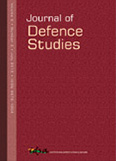A Study on Measuring the Index of Technologies (Smart and Conventional)
Humans have been developing technologies that make living easier and open unimaginable horizons. Scholars have been combining technologies to innovate and evolve newer concepts. The evolution of smart devices has led to the concept of creating smart cities. Several nations intend to develop a smart technology ecosystem for ease of governance, economic growth, and comfort of their citizens. The not-so-nascent concept of a smart city requires a scale to measure the levels of technology in the system.
- K. Rakesh Kumar |
- April-June 2023 |
- Journal of Defence Studies





